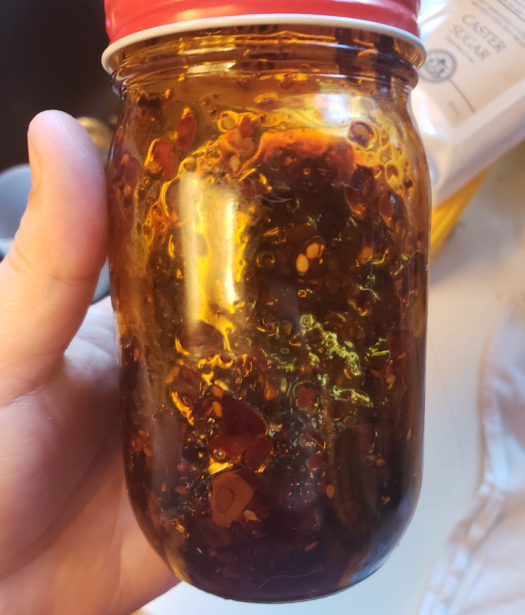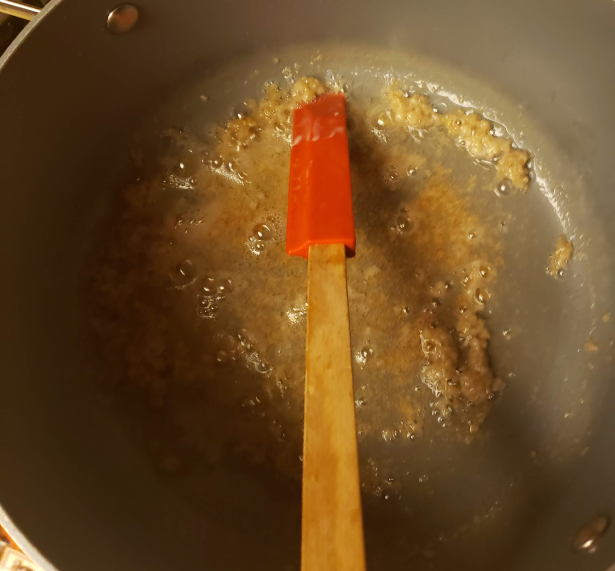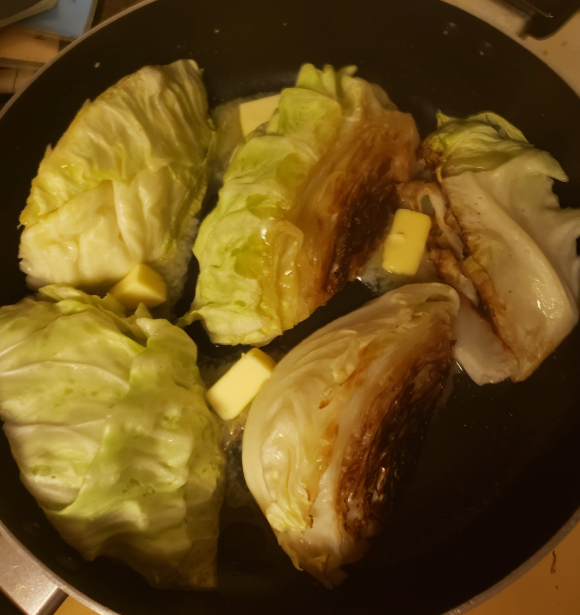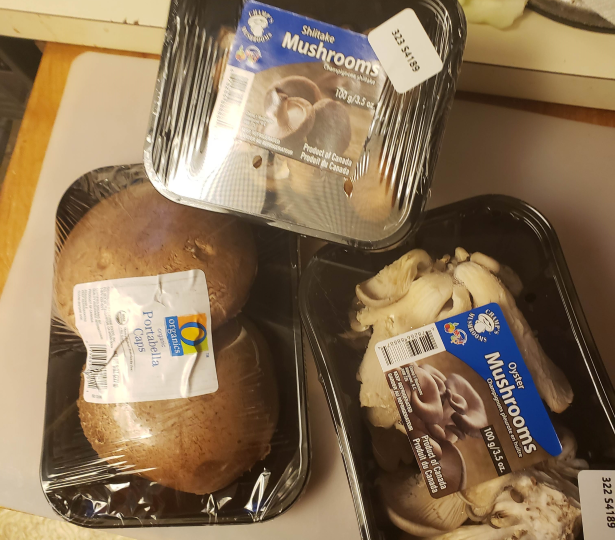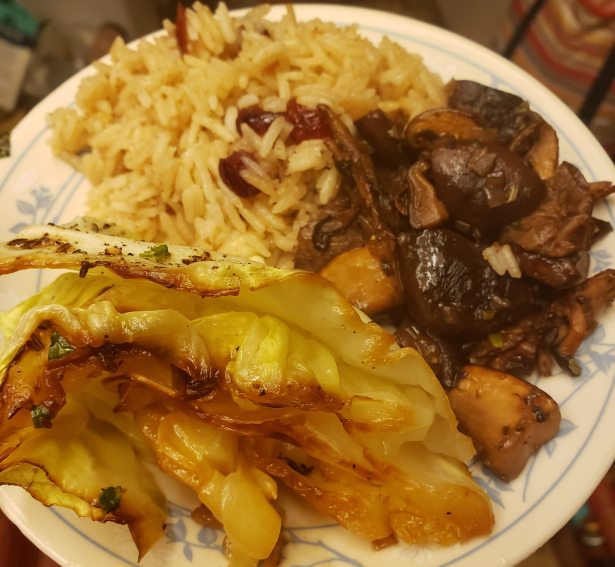KC 246 – THREE HOLIDAY SIDES

Why Hello there, and welcome to Kitchen Catastrophe. I’m your host with the most glucose, Jon O’Guin, and today, we’re doing what we do every holiday season, and slamming out the sides. Today, three vegetable sides, none of which are vegan, because….Actually, no, wait, I guess one of them Is. Damn it. ANYWHO. You can skip the talky-talky, and get straight to the walky-walky with this link, but for the rest of the walkie-talkie crew, let’s dig in, over.
Impetuous Impetus for Impractical Imp
You might recall that last year, our Thanksgiving dish was a big ol’ mess of cornbread stuffing, with jalapeños, sausage, and a home-made chili crisp that I should probably throw away, because it is definitely still on our kitchen counter.
I don’t know if I can even open this jar. It feels fused to itself.
Which of course means I’m going to try eating from this, as long as it doesn’t smell bad.
This year, I said “What if instead of doing 3+ hours of work, making what is essentially three recipes” (cornbread, chile crisp, stuffing), I do something easier?” I reflected on this, and said ‘yes. Let’s instead make three recipes in a single hour”. Which is not easier. It is, explicitly, requiring the same amount of work in less time, and that kind of irrational request was why I quit/was fired from my bakery job. I am aware that sentence has many tantalizing points of potential information, but I assure you, they are less interesting than you might imagine them to be.
Insanity unchecked, I leapt into action. I decided to tackle three recipes: arroz con titoté because…holy shit. Hold on. You guys. I just realized I did something smart on accident. Okay, hold on for a second, I have to recalibrate my thought process.
I MUST OPEN MY MIND TO THE SECRETS OF THE UNIVERSE, AND CHANNEL ITS WISDOM.
Alright, good. So, this is a happy accident: I definitely had NO real reason to make arroz con titoté except that “it’s an easy and interesting looking rice dish, so maybe people will want to try it instead of other rice dishes”. BUT, the other thing it is is COLOMBIAN, which is GREAT, because I definitely forgot to make a Colombian recipe last month, to promote our Patreon tie-in series where every month my family and I try a box of snacks from a country/region. SO BOOM, I made a Colombian recipe, go check out our Patreon on…………….fuck, I don’t know, Tuesday? Maybe tonight. Depends on when I get it done. And then, special bonus, NEXT week, we’ll have a Russian recipe, and another write-up! (by “special bonus”, we mean “Jon finally climbing out of chaos/depression and playing catch-up.”)
It’s also a fun tie-in, because we JUST talked briefly about different kinds of rice. Anywho, that’s Arroz con titoté, we’ll talk more about it in a second, then the other recipes we’re making are “new-school sautéed Mushrooms”, and “Skillet-roasted cabbage”. So let’s talk about what was going on with each of them.
The Rice More Nice.
So, arroz con titoté was the recipe I started first, because it takes the longest: about 50-60 minutes, all told. Now, if you speak Spanish, you know that this means “Rice with Titoté” and a WISH I could tell you what that means. By which I mean, I have no idea what the root of titoté is. I SPEAK Spanish. And I have no idea. Like, é at the end of a word tends to imply that either it’s an –ar verb conjugated in the first person past. (for instance, Hablé is “I spoke”) OR, if its’ és, it’s one of the ways Spanish creates demonyms (like, Inglés is “English”, taiwanés is “Taiwanese”, etc) Now, I can tell you what it REFERS to: titoté is something pretty wild: coconut caramel flakes. What does that mean? Check it out.
First, you dump a can of coconut milk (preferably without additives, according to the recipe I’m using, since they can screw this process up) into a pot, and bring it to a boil, covered. Boil it for like, 12 minutes.
This is not quite boiling, but it’s here to set up visual contrast.
What you’re doing here is getting the coconut mixture agitated, and boiling out the water. Because what you’re going to do uncover it, and then the coconut milk is going to collapse. See, coconut milk is more fat than water, and fat doesn’t evaporate. So after a couple minutes, you’re going to end up with coconut solids and coconut oil as all the water boils out. You’re then going to KEEP GOING, frying the coconut solids in the coconut oil. This is some wild stuff to watch happen, because the molten coconut oil is like, crystal clear, and the coconut solids are going to start browning. So you start with bubbling white liquid, and end up with this.
Yeah, THAT’S how different it gets over 20 minutes.
The brown stuff in there? THAT’S titoté. And I can’t figure out why. It’s not connected to any of the words I know for “caramel” or “brown”, or pieces, flecks, burnt, nothing like that. There’s no towns or cities named like, Titot. There’s no relevant verb that looks like that. I suspect that it’s like, a loanword from a local language, but that’s just a guess.
Anywho, what this process does is reduce a lot of the coconut-y flavor out of the coconut, and reduces the sweetness of it too. To this, you add some rinsed long-grain rice (rinsed just to ensure there’s not excess starch on the outside that might burn), and mix it up to coat. Let it cook for a minute or two, stirring, just to be sure that every grain is covered. Then, you gotta deglaze with that most potent of options: water. See, a lot of those browned bits of coconut caramel have adhered to your pan, and you gotta pry them off. A half cup of water and a wooden spoon (wood works better than plastic, for reasons I don’t fully understand, but guess is something like “on a microscopic level, wood’s porosity makes it more jagged.”) and about a minute of effort will get your pan cleaned up, and the tasty brown bits off your pan and into your rice.
Then you add 3 ingredients, one of which I changed. You add raisins, brown sugar, and salt. The brown sugar helps restore a little bit of the sweetness you’ve fried out, while also making it more complex. The salt reduces bitterness and balances some of the sugar, and the raisins are for color and little pockets of sweetness. However, my brother doesn’t like raisins, and this is Thanksgiving themed, so I went with Craisins instead. Once those are in, add more water, and just…cook this pot like rice: bring it to a boil, cover, reduce heat and simmer 20 minutes, and then let steam off the heat for 10 minutes.
It looks kinda like Rice-a-roni.
We’ll talk about how it tastes at the end. Meanwhile, let’s jump to our SECOND longest recipe, and second most complex (irritatingly, the shorter the recipes today, the more complicated.)
Cribbing some Cabbage Cash
Skillet Roasted Cabbage is…an idea. I can’t really say “good” or “bad”, but it’s an idea. Look, cabbage is pretty freakin’ healthy: a pound of cabbage has only 250ish calories, all your daily fiber, like, 600% your daily vitamin C, 50% of your daily potassium, over a quarter of your daily protein (which feels like it can’t be right) It’s great for you. It’s also like, the poster child for “vegetables that are terrible to eat when cooked poorly”. So good news: this is recipes I screwed up the most. And it started right from the get-go: see, you’re cutting a single 2 pound cabbage head for this. And Cabbage, when it breaks down, is NOT very structurally sound. So to keep everything in order, you need to cut it so that every wedge has the core still attached, so it doesn’t just fall apart. I missed so badly that literally HALF of my wedges had no core.
I was tempted to organize a scientific expedition to set off a nuke to fix it, but I figured 16 year old references to weird bad movies only need so much effort.
Now, theoretically, this is also a pretty simple recipe: you pop the cabbage into a skillet, steam/sear it on one side for 20ish minutes until it’s got some nice color, flip it to the other side, baste it with a flavored butter mix, bing bang boom. Couple problems happened for me. Firstly: pan size. For some reason, the pans that my family default to using just never seem to match what is implied in the recipes. They are 12 inch skillets, but some recipes they’re too big, others, too small. This was the latter: Our cabbage was packed TIGHT in the pan over a small amount of water mixed with a small amount of oil. Once in the pan, you sprinkle them with salt, and they’re just supposed to cook for up to 20 minutes, giving you plenty of time to stir the bubbling coconut milk from the arroz, and start chopping mushrooms for the third recipe, or, you know, more sanely: take a break/start on the entrée to your meal.
Once they’ve seared, flip them to the other side, add a little water, and sear on that side, covered.
Now, here’s where things start to fall apart in this whole operation. See, this side is only supposed to sear/steam for about 5 minutes. But at this juncture, I’ve started chopping the mushrooms, I’m measuring out the ingredients for the arroz since the coconut solids are browning, AND I’m trying to take some pictures, and I’ve got to chop up stuff for the next step of this So I leave this side down for longer than maybe I should. Which….”luckily”, doesn’t burn this side. In fact, this side barely gets any color at all! Stupid old stove.
Once you’ve either A: gotten some good color on this side, and softened up the wedges a little, or B: stopped flailing at your other recipes long enough to come back to this one, it’s time for step 3, which REALLY suffers from the aforementioned pan crowding: see, at this point, you add 4 tablespoons of butter…
You wanna know how bad this is? You can’t see it, but this is actually EXAGGERATING the amount of room here, because you can’t see where the pan tilts up.
Let that melt down, and then add several flavoring agents: specifically, cracked black pepper, chopped fresh basil, and ½ a teaspoon of caraway seeds. Caraway seeds, if you haven’t cooked with them before, are actually pretty common in various cabbage dishes, since they’re kind of like bitter anise. (they’re also very common in Rye bread) The three ingredients are supposed to flavor the butter, which is then basted over the cabbage. But…Look at that pan. When I added my seasonings, most of them landed on cabbages and stayed there, or clumped up around the edges of them. I did what basting I could, given the overcrowded conditions
Once basted, you’re supposed to move the cabbage to serving platter, mix a tablespoon of lemon juice into the remaining butter and seasonings, and create a small pan sauce that you pour over the cabbage and serve.
Remember, when doing something like this, ALWAYS put the best looking one on top.
Great looking stuff, how does it taste? Stay through the mushrooms to find out.
My Mind is Turning to Mush
The “new School sautéed mushrooms” from Cook’s Illustrated are the most complicated recipe we’re tackling today, as well as the most expensive, and, irritatingly, the one that turned out the best. I say irritatingly because I was SWAMPED while making it, so I have functionally NO pictures of the process. But, we’ll see what we can explain.
Now , the first step here is to pick your mushrooms. According to the authors of the reipe, they’ll work with a variety of main-stream mushroom options. (They IMPLY any mushroom, but I legitimately doubt that. For one thing, technically, Truffles are mushrooms, and I doubt you can sear 1” cubes of truffle and get anything that isn’t utter madness that’s also fairly disgusting.) I did, however buy a variety of mushrooms to use in this, since my family quite likes mushrooms.
We’re fungus FIENDS in the O’G crib.
Quick Walk-through for the unfamiliar: Those are, as the labels say, Portobello, Oyster, and Shiitake mushrooms. I also used a couple cremini mushrooms (also called baby bellos/as, or brown buttons). Portobellos are the big honkers, often used for like, mushroom burgers or mushroom steaks, because mushrooms are already kind of meaty both in texture and flavor, with a kind of spongy resistance, and portobellos are naturally the size of a standard burger patty. Season those suckers and cook them up, and they’re a solid option. Fun fact that I know I’ve already said before, but cremini mushrooms are just smaller Portobellos. (hence the “Baby Bello” name), and white mushrooms are just a weird quasi-albino offshoot of the same thing. Shiitake (shi-TAH-kee) mushrooms are, as the name implies, Japanese. They’re a little chewier than ‘normal’ mushrooms, with a more smoky/woodsy taste. Oyster mushrooms are lighter in flavor, often said to taste vaguely like seafood. For this recipe, I cubed the portobellos, trimmed the stems from the shiitakes and cremini (shiitake stems are much more woody, so they’re almost always trimmed and discarded. You don’t have to do the same with cremini, but you’re supposed to trim like, the very ends off, and if I’m already doing that, I don’t really like the stem anyway, so BYE.) and just tore up the oyster mushrooms.
Now, this recipe is called “New school”, because it kind of goes against the classical understanding of how to sauté mushrooms. Basic overview: Mushrooms taste best when browned. But there’s a problem there: Mushrooms can absorb a lot of water, and water is the enemy of browning. As they heat up, they leak their own water. So most sautéed mushroom recipes are very clear: don’t add salt, because it’ll make the mushrooms leak MORE water, and just…endure the process of getting them to break down and start browning.
DO IT. BREAK DOWN AND WEEP YOUR MUSHROOM TEARS.
Turns out, there’s a slightly easier way: see, first off, it’s basically impossible to overcook mushrooms, due to how they’re built on a cellular level. (Mushrooms are made of chitin, aka, “what lobster shells are”, just much thinner) They’re not going to get fall-apart soggy, or turn into hard rocks unless you actively burn them into charcoal. This means that as long as there’s some oil/water in the pan, you can keep these suckers on high heat for quite a while. Second, it turns out that high-heat steam is very useful for breaking down plant/fungal cells. This is complicated, but basically: steam can get hotter than water can, but can also access/abuse surface tension and permeable membranes. So using a very hot pan, and boiling off a small amount of water will cause the mushrooms to break down faster, leaking their own liquid out. Yes, adding water will cause the water to run out faster, because cooking and science sometimes do dumb things.
Then, because the mushrooms have collapsed more, they absorb less oil, so you go from a couple tablespoons to less than a teaspoon.
And you’d think that’s it, right? Well, yes and no. Technically, you could stop there, and these would be sautéed. But, typically, you do cook some aromatics or make a sauce. Well, this recipe does both…and processing them, while wrapping up the other two recipes, prevented me from photographing any of it. In fact, I had to call in Nate to give me an extra set of hands to pull it off. Which is particularly frustrating, because it’s actually a pretty simple process:
-the aromatics are just a single minced shallot (so a slightly sweeter onion flavor), and some minced fresh rosemary. Clear out the middle of the mushrooms, drop the heat to medium, melt a pat of butter, and get a quick sauté on these suckers to wake them up, before you add the base of the sauce
-The sauce has a base of red wine and a tablespoon of cider vinegar. It brings acidity, brightness, complex flavors. Cook them down a little, then you add chicken broth, and toss it all until the sauce thickens up and coats the mushrooms.
Shining, shimmering, splendid.
And that’s it. Once the sauce is cooked down, they’re ready. So, how’s the whole shebang?
Vegetal.
The unanimous consensus of the house is: the mushrooms are the best, the Rice is good, and the cabbage is…not bad, but just okay. The mushrooms have a variety of textures, thanks to the variety of types, and the sauce is somewhat subtle, in that it’s not punching you in the face with salt or wine, but it just generally tastes like warmth and good cooking. The Rice is a little coconut-y, but similarly mostly just conveys a kind of warming pilaf effect. The Cabbage…didn’t really taste like much beyond cabbage to me. Nate says he tasted the seasonings, and he didn’t think they worked all that well. I think that one needs another attempt, with more attention and less crowding, to see if it’s a matter of simultaneously over and undercooking. (given that the second side didn’t really sear, and overall I think they were a little overly softened. Not too far, but just enough to be an issue.)
For a sense of scale, my mother went back for more mushrooms and rice, which is a fairly rare event with stuff I make. She did NOT get any cabbage. And hey, when you’re cramming 3 experimental builds into one jam-packed hour of culinary creation, 2 out of 3 successes ain’t bad.
THURSDAY: IT’S THANKSGIVING, SO WE’LL CONTINUE OUR TRADITION OF REVIEWING A THANKSGIVING SPECIAL.
MONDAY: ASSUMING ALL GOES AS PLANNED, WE SHALL EAT CAKE.
Here's a slate of
Recipes
Arroz Con Titoté, Thanksgiving Style
Makes 4-6 servings
Ingredients
1 (14 oz) can coconut milk
1.5 cups long grain rice, rinsed until water runs clear
2 ¼ cups water, divided into ½ cup and 1 ¾ cup.
1/3 cup dried cranberries
2 packed tablespoons dark brown sugar
1 teaspoon table salt
Lime wedges (optional)
Preparation
In a large saucepan or pot, pour the can of coconut milk. Cover (with the lid slightly ajar) and boil over medium-high heat for 10-12 minutes, until the milk has reduced to about 1/4, and is beginning to sputter. Reduce the heat, uncover, and cook stirring frequently, until the coconut fat and solids separate, 2-4 minutes. Continue cooking until coconut solids brown, another 3-5 minutes.
Add the rice to pan, and stir until rice is well-coated in fat. Add ½ cup water, and, using a wooden spoon, scrape up any brown bits stuck to the bottom or sides of the pan. Add the cranberries, dark brown sugar, table salt, and remaining water. Stir to combine, re-cover the pot, and bring to a boil.
Reduce heat to a simmer, and let cook for 20 minutes, until water is absorbed. Move from the heat, and let steam with the lid on for an additional 10 minutes. Stir to ensure mixture is well-balanced, and serve with lime wedges (or don’t)
Skillet-Roasted Cabbage
Serves 4-6
Ingredients
1 head cabbage (roughly 2 pounds)
6 tbsp water, divided into ¼ cup and 2 tbsp
2 tbsp vegetable oil
1 teaspoon salt
4 tbsp unsalted butter, cut into 4 chunks
3 tbsp chopped fresh basil
½ tsp black pepper
½ tsp caraway seeds
1 tbsp lemon juice
Salt and Pepper
Preparation
Cut the cabbage into 6 equal wedges, ensuring that each wedge includes a section of the core, or the wedges will fall apart. Combine ¼ cup water and vegetable oil in a 12 inch skillet, place the wedges in the skillet cut side down, and cook over medium heat uncovered for 16-20 minutes, until the wedge is well-browned.
Flip the wedges to the other cut side, adding remaining 2 tablespoons of water, and cover, cooking another 4-6 minutes, to brown the new side, and soften the wedges.
Un cover, and scatter butter around the pan, and cook until fully melted and bubbling. Add basil, caraway, and pepper. Baste cabbages with bubbling butter for 1-2 minutes, then move the wedges to a serving platter.
Add the lemon juice to remaining butter/liquid in the pan, and stir to combine. Spoon over wedges and serve, adding salt and pepper to taste.
New School Sautéed Mushrooms
Serves 4
Ingredients
1 ¼ pounds mushrooms (your choice)
¼ cup water
½ tsp vegetable oil
1 tbsp unsalted butter
1 shallot, minced
1 tsp minced fresh rosemary
1/4 tsp salt + ¼ tsp pepper
¼ cup red wine
1 tbsp cider vinegar
½ cup chicken broth
Preparation
Cook the mushrooms and water in a 12 inch non-stick skillet over high heat for 4-8 minutes, stirring occasionally, until the skillet is almost dry, and the mushrooms are sizzling. Reduce the heat to medium-high, add the vegetable oil, toss to coat, and cook another 4-8 minutes until browned.
Drop the heat to medium, move the mushrooms to the edges of the pan, and add the butter to the center of your pan. Melt it, add the shallot, rosemary, salt and pepper. Cook for 30 seconds to 1 minutes until aromatic. Add the wine and vinegar, stir into the mushrooms, and cook until the liquid has evaporated, 2-3 minutes. Add the broth, and cook until it’s reduced down and coats the mushrooms, another 3-4 minutes. Season with salt and pepper and serve.

